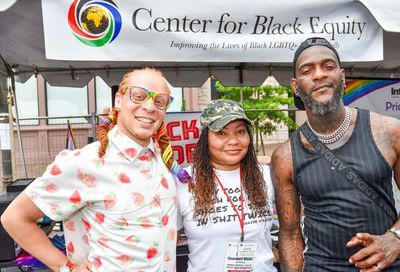Study Claims 94% of Trans Youth Persist in Gender Identity Post-Transition
American Association of Pediatrics study finds majority of transgender youth subjects persisted in their gender identity five years after transitioning socially.

A new study published by the American Association of Pediatrics claims that children who transition younger in life are very likely to persist in their gender identity after transitioning.
The study, which included over 300 transgender youth participants, found that 94% of those who transitioned socially — referring to non-medical intervention process during which a person may adopt gender-affirming pronouns, a first name, and hairstyles and clothing that align with their gender identity — still identified as a binary (male or female) transgender person five years after beginning the transition process.
Only 2.5% of youth in the study “retransitioned,” or began identifying with their assigned sex at birth.
“Fewer than 2.5% of children who made that initial social transition ended up identifying as their sex assigned at birth at the conclusion of the five-year study. That means that over 97, almost 98% of the children in that study persisted in their gender diverse identities over time,” Dr. Melissa Cyperski, Clinical Psychologist with Vanderbilt University Medical Center, told Nashville NBC affiliate WSMV.
As a clinical psychologist, Cyperski reviews letters of support for patients seeking to medically transition before they get admitted to VUMC’s Pediatric Transgender Health Clinic.
“Identifying as gender diverse is something that many kids have thought about for years upon years, and then finally found the courage to share who they are with people who are close to them,” Cyperski said.
According to Cyperski, there are two main phases of transitioning — although what the process will look like specifically depends on the individual. The first phase is social transition, which involved changing one’s name, pronouns, and aspects of their physical appearance, and having their gender identity affirmed by people in their lives, such as friends, parents, relatives, and teachers. Then, if the person chooses, they may start the second phase, which is medical transition, using puberty blockers, hormone therapy, or surgery, commonly referred to as “gender-affirming care.”
Surgical interventions are largely not performed on minors, although some minors may, with parental permission, begin puberty blockers or hormones, based on their personal social and physical development, their degree of readiness to transition and their maturity level.
Recently, some state lawmakers have attempted to restrict access to gender-affirming care, even passing laws designed to punish doctors who provide gender-affirming care to minors or encouraging state welfare officials to investigate parents who allow their children to access such care for “child abuse,” potentially setting up the possibility that the children could be removed from their parents’ custody.
However, many experts in transgender health care agree that allowing gender dysphoria to go untreated may potentially harm transgender youth by exacerbating their feelings of depression, loneliness, or isolation and potentially leading to suicidal ideation. In some cases, youth who cannot access gender-affirming care may seek out hormones or other treatments on the underground market, or may engage in self-harming behaviors, including but not limited to eating disorders, due to their feelings of gender dysphoria.
Proponents of bans on medical interventions on transgender minors frequently argue that children are too young to understand the ramifications of transitioning, that treatments will negatively impact their physical development and lead to life-long health problems.
More importantly, in terms of the AAP study, those opposed to allowing minors to transition have claimed that the overwhelming majority of individuals who experience gender dysphoria will eventually “grow out of” those feelings and come to accept their assigned sex at birth. As such, they argue, beginning medical interventions, like hormone therapy, early in life will lead to fertility issues and may one day cause individuals to regret having transitioned.
But if the AAP study’s findings are to be believed, the fact that the overwhelming majority of children who socially transition at a young age appear to remain consistent in their gender identity flies in the face of arguments in favor of restricting gender-affirming treatments.
There are also those who oppose even allowing children to socially transition, even though that process involves no medical interventions.
Cyperski says physicians have a standard procedure for gender-affirming care, which first involves waiting until the person who wishes to transition reaches the right age to begin the process.
“We’re waiting for them to be in puberty to consider and possibly initiate any type of medical intervention,” she says.
Advocates for transgender youth also point to cases in which transgender adults have not regretted transitioning as evidence that starting social transition for children who begin expressing feelings of gender dysphoria early in life is not as harmful as critics say it is.
Jace Wilder, a master’s student at Vanderbilt University who is studying public health, with a focus on LGBT health policy, told WSMV that his decision to socially transition after his freshman year of college helped him discover a better life.
“I always kind of felt different from the other kids. I never really fully understood where I belonged when it came to gender,” Wilder said. “I finally started honoring it. And in that came a lot of difficulties of bullying, and discrimination. But I still found, using my name, using my pronouns, and trying to find support around me was still so much better living that way.”
Support Metro Weekly’s Journalism
These are challenging times for news organizations. And yet it’s crucial we stay active and provide vital resources and information to both our local readers and the world. So won’t you please take a moment and consider supporting Metro Weekly with a membership? For as little as $5 a month, you can help ensure Metro Weekly magazine and MetroWeekly.com remain free, viable resources as we provide the best, most diverse, culturally-resonant LGBTQ coverage in both the D.C. region and around the world. Memberships come with exclusive perks and discounts, your own personal digital delivery of each week’s magazine (and an archive), access to our Member's Lounge when it launches this fall, and exclusive members-only items like Metro Weekly Membership Mugs and Tote Bags! Check out all our membership levels here and please join us today!




























You must be logged in to post a comment.